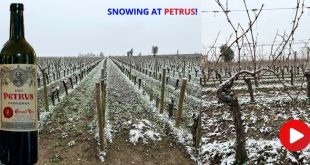Nino Franco Prosecco, on the other hand, is a completely different proposition. The wines possess vibrant, persistent fruit; structure; balance, lingering finish, and are thoroughly refreshing.
Grave di Stecca is the Le Mesnil of Prosecco. Except that in 2009, Primo Franco took the wine out of the DOCG and, in that liberation, created a unique spumante from a south-facing, sloping walled vineyard or clos of Valdobiaddene.
2019 celebrates the centenary of Cantine Franco. It was founded in 1919 in Valdobbiadene by Antonio Franco who set out to make a quality wine from the very first bubble. The winery grew under his son Nino even as the brand became more well-known. But, it was the third generation that made the brand Nino Franco what it is today.
Primo – at first with his father and then solo – modernised the winery. Armed with a diploma from the Conegliano Veneto School of Oenology – and complemented by travels, observation and reflection – Primo Franco was convinced that to produce a great wine, you need to control production not just from a technical point of view but also the raw material, namely grapes, in this case the glera.

For his vision and boldness in shaking up Prosecco, Primo Franco has been likened to what Pierro Antinori and Angelo Gaia have done for Tuscany and Piedmont respectively.
Primo Franco assumed responsibility for the family winery in 1982. Then, at the start of the 1990s , he took over a vineyard and experimented with different methods of planting even as he cultivated old clones. At the same time, Primo worked closely with local growers to produce ever better fruit so that what emerges from every bottle of Nino Franco Prosecco is not just pristine glera but a variety that speaks of a sense of place – the terroir – of Valdobbiadene and the Prosecco hills.
For his vision and boldness in shaking up Prosecco, Primo Franco has been likened to what Pierro Antinori and Angelo Gaia have done for Tuscany and Piedmont respectively.
Tasting Notes
Nino Franco Rustico Brut

‘This is our entry level wine and has 10 gm of residual sugar,’ Primo Franco informed over dinner on 7 June 2019 at Cherry Garden, the Cantonese restaurant on Level 5 of the Mandarin Oriental Singapore. At 4.85 atmospheres, the tenancity of the bubbles is closer to cremant than champagne which pressure is usually 6 atmospheres. Lovely pear fruit chased relentlessly by freshness.
Nino Franco Primo Franco 2017
 Appley fruit with a hint of melons. Fruit and freshness in every sip. Produced annually since 1983 (a year after Primo Franco became in charge of his family winery), the dosage is 28 to 30 gm of residual sugar per litre which would mean the wine is a sec (17 to 32 gm of sugar per litre). You don’t feel the sweetness because the fruitiness and freshness are so effortlessly balanced.
Appley fruit with a hint of melons. Fruit and freshness in every sip. Produced annually since 1983 (a year after Primo Franco became in charge of his family winery), the dosage is 28 to 30 gm of residual sugar per litre which would mean the wine is a sec (17 to 32 gm of sugar per litre). You don’t feel the sweetness because the fruitiness and freshness are so effortlessly balanced.
Nino Franco Primo Franco 2014
Yellow flowers and a honey note. Textured. The creamy sweetness of fruitiness is wrapped in vivacity.
Nino Franco Primo Franco 1998

This was a surprise which Primo Franco hand-carried all the way from Valdobiaddene to Singapore (via Hong Kong where he also visited). The Italian should had put on a Santa Claus costume because for this exceptional bonus. Golden in complexion. Tertiary aromas of sandalwood, straw, minerality, hint of beewax, a dash of petrol and reminding so much of a chenin blanc from Vouvray. 21 years young! A revelation of what Prosecco is capable of! Primo Franco informed that, co-incidentally, he used to have 600 chenin blanc vines – originally from a French nursery – in the vineyard because Vouvray which produces Moelleux, Sec and Demi-Sec wines has much in common with Prosecco.
 Grave di Stecca, its tensioned, minerally fruit, dryness, firmness and structure is the Le Mesnil of Prosecco. Except that in 2009, Primo Franco took the wine out of the DOCG and, in that liberation, created a unique spumante from a south-facing, sloping walled vineyard or clos of Valdobiaddene.
Grave di Stecca, its tensioned, minerally fruit, dryness, firmness and structure is the Le Mesnil of Prosecco. Except that in 2009, Primo Franco took the wine out of the DOCG and, in that liberation, created a unique spumante from a south-facing, sloping walled vineyard or clos of Valdobiaddene.
Nino Franco Grave di Stecca Brut 2013
Grave di Stecca is a single vineyard that is a clos or walled property. The vineyard is on south-facing slopes in Valdobiaddene. Planted in 1993, a still wine is also produced. The stony soil gives the vineyard its name “Grave” which is not unlike Graves in Bordeaux. Like all the above wines, it is produced from 100% glera and the bubbles are obtained through the charmat or “cuve close” or closed tank method. Except the bubbles are so very fine, and the dosage is a low 7 gm. The wine is very minerally and flinty. The intensity of the fruit and the tension/backbone of the structure is such that, for me, this is best described as Le Mesnil of Prosecco. Here, though, is the paradox and problem. The governing authorities of Prosecco found Grave di Stecca so unlike normal Prosecco that they had problems awarding it DOCG status. In return, Primo Franco did a one-upmanship on them because in 2009, he liberated Grave di Stecca from DOCG consideration. And simply described it as spumante. Grave di Stecca is in a class of its own. And very sought after and highly prized and priced.
Nino Franco Grave di Stecca Brut 2008
Limes and lemons. Minerally. Intense fruit and riveting freshness. Incredibly youthful. Very, very long future ahead. Co-incidentally, 2008 is also one of the greatest vintages of Champagne ever.
Nino Franco Grave di Stecca Brut 2007
Quince, herbs and suggestions of stone fruit. The minerality has an elegant richness. Although merely a year separates them, the texture is rounder and more evolved than 2008 which is slightly reductive. Both wines show what a magnificent vineyard Grave di Stecca is capable of.


